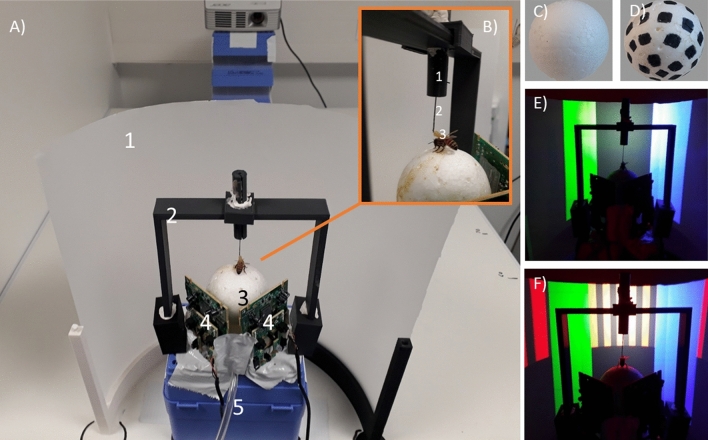Figure 1.
Experimental setup for 3D virtual-reality (VR) studies in honey bees. (A) Global view of the VR system. 1: Semicircular projection screen made of tracing paper. 2: Holding frame to place the tethered bee on the treadmill. 3: The treadmill was a Styrofoam ball positioned within a cylindrical support (not visible) and floating on an air cushion. 4: Infrared mouse optic sensors allowing to record the displacement of the ball and to reconstruct the bee’s trajectory. 5: Air arrival. (B) The tethering system. 1: Plastic cylinder held by the holding frame; the cylinder contained a glass cannula into which a steel needle was inserted. 2: The needle was attached to the thorax of the bee. 3: Its curved end was fixed to the thorax by means of melted bee wax. (C, D) Two types of Styrofoam balls used for assessing the importance of the ventral optic flow. (C) No ventral optic flow provided. (D) Ventral optic flow provided. (E) Color discrimination learning in the VR setup. The bee had to learn to discriminate a rewarded from a non-rewarded color cuboid. Cuboids were green and blue. In this case color training and testing was set in the ‘Transparent Condition’, i.e. no background was provided and the VR display contained only the two colored cuboids on an empty dark background. (F) Same as in (E) but in this case, the vertical background of the VR arena was covered by a vertical grating made of black and reddish bars. Depending on its movements, the background gave origin to three different conditions: the ‘Vertical Grating—Optic Flow Condition’, in which the grating was set in closed loop conditions with respect to the bee movements; the ‘Vertical Grating—No Optic Flow Condition’, in which the grating was moved in synchrony with the bee’s gaze so that no motion cues could be derived from the background; and the ‘Rotating Vertical Grating Condition’, in which the grating was displaced in the anti-clockwise direction across the screen at a constant speed, thus generating a constant optic flow that was independent of the bee’s movements.

